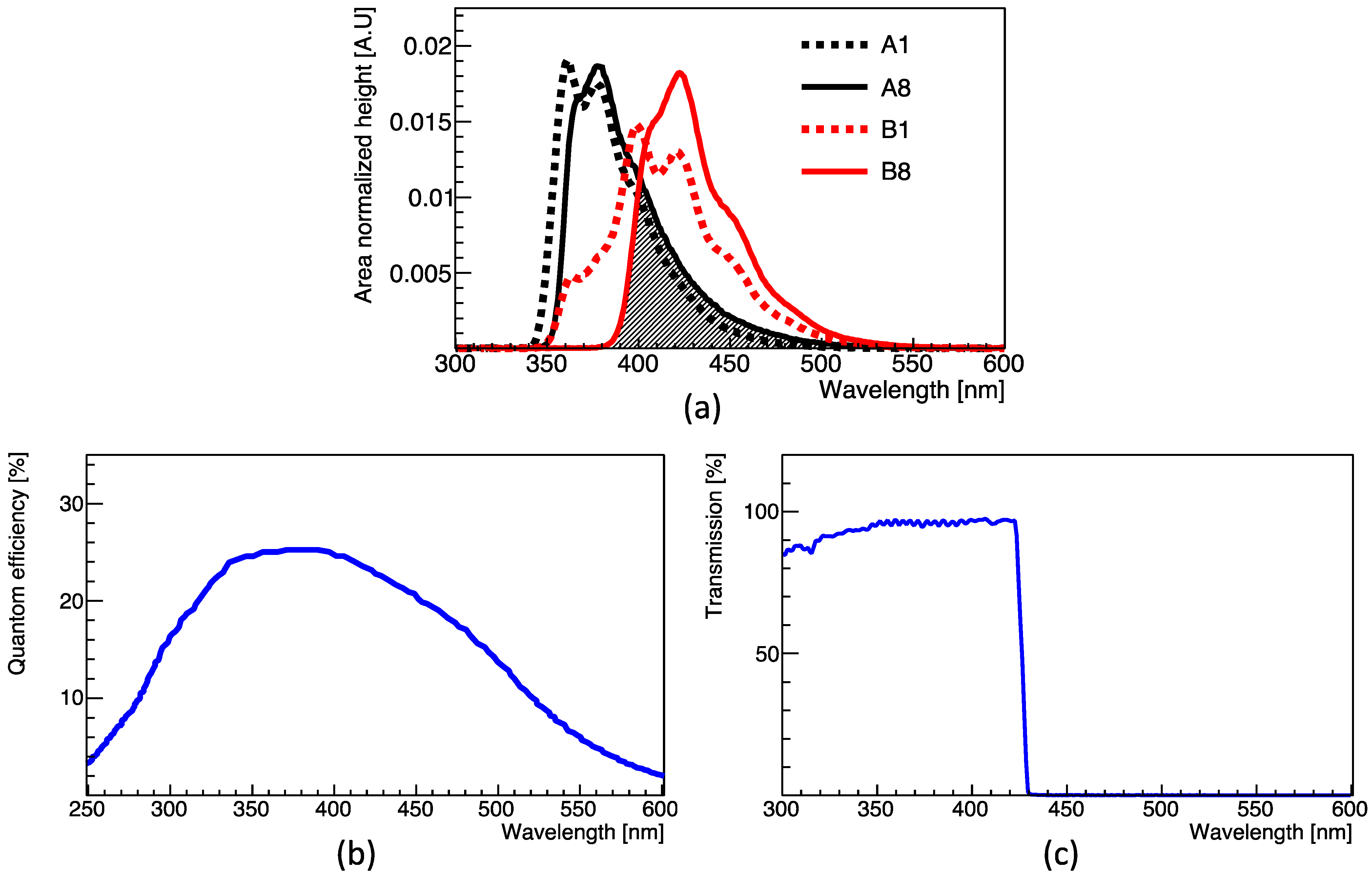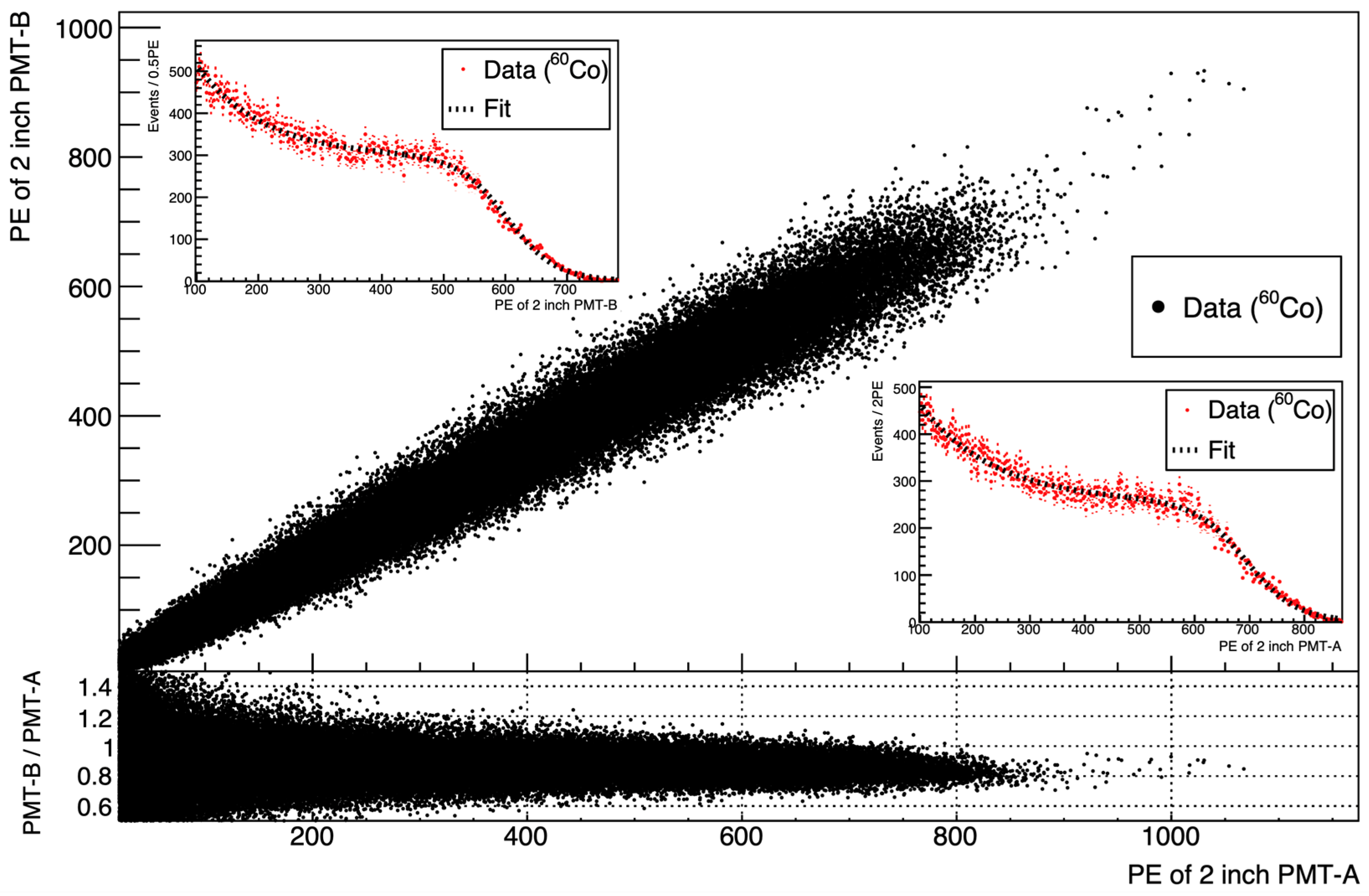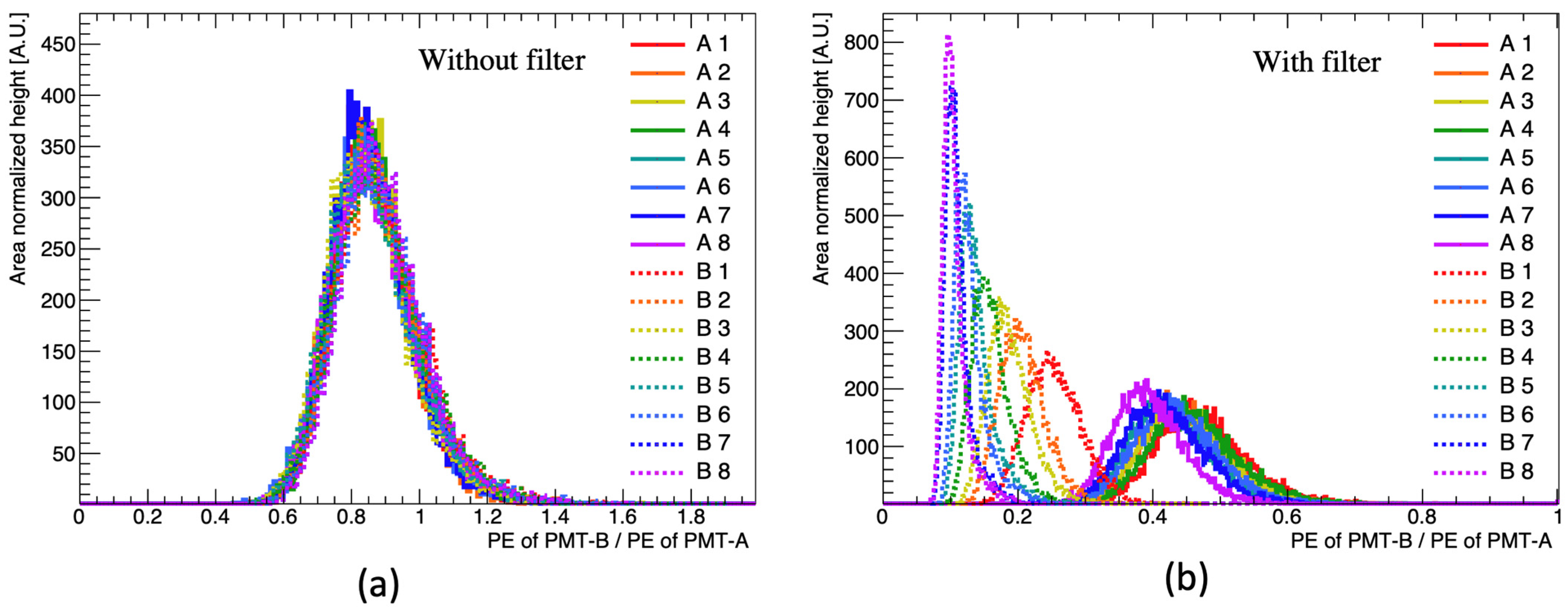Feasibility Study on the Discrimination of Fluor Concentration in the Liquid Scintillator Using PMT Waveform and Short-Pass Filter
Abstract
1. Introduction
2. Preparation of LS Samples
3. Experimental Setup
4. Measurements & Results
4.1. Light Yield Measurement
4.2. Pulse Shape Measurement
4.3. Wavelength Shift Measurement
4.4. Observed LS Response with Different Fluor Concentration
5. Summary
Author Contributions
Funding
Institutional Review Board Statement
Informed Consent Statement
Data Availability Statement
Conflicts of Interest
References
- An, F.; An, G.; An, Q.; Antonelli, V.; Baussan, E.; Beacom, J.; Bezrukov, L.; Blyth, S.; Brugnera, R.; Avanzini, M.B. Neutrino physics with JUNO. J. Phys. G Nucl. Part. Phys. 2016, 43, 030401. [Google Scholar] [CrossRef]
- Proto-Collaboration, H.-K.; Abe, K.; Aihara, H.; Andreopoulos, C.; Anghel, I.; Ariga, A.; Ariga, T.; Asfandiyarov, R.; Askins, M.; Back, J. Physics potential of a long-baseline neutrino oscillation experiment using a J-PARC neutrino beam and Hyper-Kamiokande. Prog. Theor. Exp. Phys. 2015, 2015, 053C002. [Google Scholar]
- Acciarri, R.; Bansal, S.; Friedland, A.; Djurcic, Z.; Rakotondravohitra, L.; Xin, T.; Mazzucato, E.; Densham, C.; Calvo, E.; Li, S. Long-Baseline Neutrino Facility (LBNF) and Deep Underground Neutrino Experiment (DUNE): Volume 1: The LBNF and DUNE Projects. arXiv 2016, arXiv:1601.05471. [Google Scholar]
- Adam, T.; An, F.; An, G.; An, Q.; Anfimov, N.; Antonelli, V.; Baccolo, G.; Baldoncini, M.; Baussan, E.; Bellato, M. JUNO conceptual design report. arXiv 2015, arXiv:1508.07166. [Google Scholar]
- Chen, H.-t.; Yu, B.-x.; Shan, Q.; Ding, Y.-y.; Du, B.; Liu, S.-t.; Zhang, X.; Zhou, L.; Jia, W.-b.; Fang, J. Aging research of the LAB-based liquid scintillator in stainless steel container. arXiv 2014, arXiv:1409.1298. [Google Scholar]
- Abusleme, A.; Adam, T.; Ahmad, S.; Aiello, S.; Akram, M.; Ali, N.; An, F.; An, G.; An, Q.; Andronico, G. Optimization of the JUNO liquid scintillator composition using a Daya Bay antineutrino detector. Nucl. Instrum. Methods Phys. Res. Sect. A Accel. Spectrometers Detect. Assoc. Equip. 2021, 988, 164823. [Google Scholar] [CrossRef]
- Choi, J.-W.; Choi, J.-Y.; Joo, K.-K. Estimation of Fluor Emission Spectrum through Digital Photo Image Analysis with a Water-Based Liquid Scintillator. Sensors 2021, 21, 8483. [Google Scholar] [CrossRef]
- Choi, J.W.; Choi, J.Y.; Jang, H.I.; Joo, K.K. Feasibility Study of Convolutional Neural Networks for a Slow Control System and Fluor Discrimination in Emission Spectrum of Liquid Scintillator. 2022. Available online: https://www.npsm-kps.org/journal/view.html?doi=10.3938/NPSM.72.582 (accessed on 14 February 2023).
- Onken, D.R.; Moretti, F.; Caravaca, J.; Yeh, M.; Orebi Gann, G.D.; Bourret, E.D. Time response of water-based liquid scintillator from X-ray excitation. Mater. Adv. 2020, 1, 71–76. [Google Scholar] [CrossRef]
- Zhang, Y.; Yu, Z.Y.; Li, X.Y.; Deng, Z.Y.; Wen, L.J. A complete optical model for liquid-scintillator detectors. Nucl. Instrum. Methods Phys. Res. Sect. A Accel. Spectrometers Detect. Assoc. Equip. 2020, 967, 163860. [Google Scholar] [CrossRef]
- Beriguete, W.; Cao, J.; Ding, Y.; Hans, S.; Heeger, K.M.; Hu, L.; Huang, A.; Luk, K.-B.; Nemchenok, I.; Qi, M. Production of a gadolinium-loaded liquid scintillator for the Daya Bay reactor neutrino experiment. Nucl. Instrum. Methods Phys. Res. Sect. A Accel. Spectrometers Detect. Assoc. Equip. 2014, 763, 82–88. [Google Scholar] [CrossRef]
- Park, J.S.; Lee, J.; Yeo, I.S.; Choi, W.Q.; Ahn, J.K.; Choi, J.H.; Choi, S.; Choi, Y.; Jang, H.I.; Jang, J.S.; et al. Production and optical properties of Gd-loaded liquid scintillator for the RENO neutrino detector. Nucl. Instrum. Methods Phys. Res. Sect. A Accel. Spectrometers Detect. Assoc. Equip. 2013, 707, 45–53. [Google Scholar] [CrossRef]
- Anderson, M.; Andringa, S.; Anselmo, L.; Arushanova, E.; Asahi, S.; Askins, M.; Auty, D.; Back, A.; Barnard, Z.; Barros, N. Development, characterisation, and deployment of the SNO+ liquid scintillator. J. Instrum. 2021, 16, P05009. [Google Scholar] [CrossRef]
- Buck, C.; Gramlich, B.; Lindner, M.; Roca, C.; Schoppmann, S. Production and properties of the liquid scintillators used in the STEREO reactor neutrino experiment. J. Instrum. 2019, 14, P01027. [Google Scholar] [CrossRef]
- Li, M.; Guo, Z.; Yeh, M.; Wang, Z.; Chen, S. Separation of scintillation and Cherenkov lights in linear alkyl benzene. Nucl. Instrum. Methods Phys. Res. Sect. A Accel. Spectrometers Detect. Assoc. Equip. 2016, 830, 303–308. [Google Scholar] [CrossRef]
- Liu, Q.; He, M.; Ding, X.; Li, W.; Peng, H. A vertex reconstruction algorithm in the central detector of JUNO. J. Instrum. 2018, 13, T09005. [Google Scholar] [CrossRef]
- Photonics, H. PHOTOMULTIPLIER TUBES and Assemblies. Available online: http://www-eng.lbl.gov/~shuman/NEXT/MATERIALS&COMPONENTS/High_energy_PMT_TPMO0007E02.pdf (accessed on 14 February 2023).
- Caravaca, J.; Land, B.; Yeh, M.; Orebi Gann, G. Characterization of water-based liquid scintillator for Cherenkov and scintillation separation. Eur. Phys. J. C 2020, 80, 867. [Google Scholar] [CrossRef]
- Abbasi, R.; Abdou, Y.; Abu-Zayyad, T.; Adams, J.; Aguilar, J.; Ahlers, M.; Andeen, K.; Auffenberg, J.; Bai, X.; Baker, M. Calibration and characterization of the IceCube photomultiplier tube. Nucl. Instrum. Methods Phys. Res. Sect. A Accel. Spectrometers Detect. Assoc. Equip. 2010, 618, 139–152. [Google Scholar] [CrossRef]
- Wright, A. The Photomultiplier Handbook; Oxford University Press: Oxford, UK, 2017. [Google Scholar]
- Optics, E. High Performance OD 4 Shortpass Filters. Available online: https://www.edmundoptics.co.kr/f/high-performance-od-4-shortpass-filters/13534/ (accessed on 14 February 2023).
- Lombardi, P.; Ortica, F.; Ranucci, G.; Romani, A. Decay time and pulse shape discrimination of liquid scintillators based on novel solvents. Nucl. Instrum. Methods Phys. Res. Sect. A Accel. Spectrometers Detect. Assoc. Equip. 2013, 701, 133–144. [Google Scholar] [CrossRef]
- Jung, K.; Han, B.; Jeon, E.; Jeong, Y.; Jo, H.; Kim, J.; Kim, J.; Kim, Y.; Ko, Y.; Lee, M. Pulse shape discrimination using a convolutional neural network for organic liquid scintillator signals. arXiv 2022, arXiv:2211.07892. [Google Scholar] [CrossRef]
- Albanese, V.; Alves, R.; Anderson, M.; Andringa, S.; Anselmo, L.; Arushanova, E.; Asahi, S.; Askins, M.; Auty, D.; Back, A. The SNO+ experiment. J. Instrum. 2021, 16, P08059. [Google Scholar] [CrossRef]
- Alonso, J.; Argüelles, C.; Bungau, A.; Conrad, J.; Dutta, B.; Kim, Y.; Marzec, E.; Mishins, D.; Seo, S.; Shaevitz, M. Neutrino physics opportunities with the IsoDAR source at Yemilab. Phys. Rev. D 2022, 105, 052009. [Google Scholar] [CrossRef]








| Sample | PPO Concentration (g/L) |
|---|---|
| A1 | 0.5 |
| A2 | 1 |
| A3 | 1.5 |
| A4 | 2 |
| A5 | 3 |
| A6 | 4 |
| A7 | 7 |
| A8 | 10 |
| Sample | PPO Concentration (g/L) | bis-MSB Concentration (mg/L) |
|---|---|---|
| B1 | 3 | 1 |
| B2 | 3 | 2 |
| B3 | 3 | 3 |
| B4 | 3 | 5 |
| B5 | 3 | 10 |
| B6 | 3 | 15 |
| B7 | 3 | 30 |
| B8 | 3 | 50 |
Disclaimer/Publisher’s Note: The statements, opinions and data contained in all publications are solely those of the individual author(s) and contributor(s) and not of MDPI and/or the editor(s). MDPI and/or the editor(s) disclaim responsibility for any injury to people or property resulting from any ideas, methods, instructions or products referred to in the content. |
© 2023 by the authors. Licensee MDPI, Basel, Switzerland. This article is an open access article distributed under the terms and conditions of the Creative Commons Attribution (CC BY) license (https://creativecommons.org/licenses/by/4.0/).
Share and Cite
Kim, N.-R.; Joo, K.-K.; Lee, H.-G. Feasibility Study on the Discrimination of Fluor Concentration in the Liquid Scintillator Using PMT Waveform and Short-Pass Filter. Sensors 2023, 23, 2728. https://doi.org/10.3390/s23052728
Kim N-R, Joo K-K, Lee H-G. Feasibility Study on the Discrimination of Fluor Concentration in the Liquid Scintillator Using PMT Waveform and Short-Pass Filter. Sensors. 2023; 23(5):2728. https://doi.org/10.3390/s23052728
Chicago/Turabian StyleKim, Na-Ri, Kyung-Kwang Joo, and Hyun-Gi Lee. 2023. "Feasibility Study on the Discrimination of Fluor Concentration in the Liquid Scintillator Using PMT Waveform and Short-Pass Filter" Sensors 23, no. 5: 2728. https://doi.org/10.3390/s23052728
APA StyleKim, N.-R., Joo, K.-K., & Lee, H.-G. (2023). Feasibility Study on the Discrimination of Fluor Concentration in the Liquid Scintillator Using PMT Waveform and Short-Pass Filter. Sensors, 23(5), 2728. https://doi.org/10.3390/s23052728






